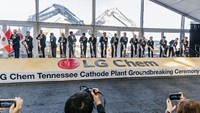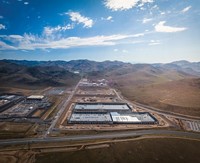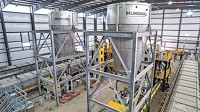Advertisement
Grab your lab coat. Let's get started
Welcome!
Welcome!
Create an account below to get 6 C&EN articles per month, receive newsletters and more - all free.
It seems this is your first time logging in online. Please enter the following information to continue.
As an ACS member you automatically get access to this site. All we need is few more details to create your reading experience.
Not you? Sign in with a different account.
Not you? Sign in with a different account.
ERROR 1
ERROR 1
ERROR 2
ERROR 2
ERROR 2
ERROR 2
ERROR 2
Password and Confirm password must match.
If you have an ACS member number, please enter it here so we can link this account to your membership. (optional)
ERROR 2
ACS values your privacy. By submitting your information, you are gaining access to C&EN and subscribing to our weekly newsletter. We use the information you provide to make your reading experience better, and we will never sell your data to third party members.
Energy Storage
Electrolyte makers chase opportunities in US battery industry
But moving those supply chains out of China presents political and permitting challenges
by Matt Blois
March 21, 2024
| A version of this story appeared in
Volume 102, Issue 9

Firms chasing opportunities in the US’ growing battery industry plan to invest more than $1 billion in US facilities that will produce electrolytes and the raw materials needed to make them. But establishing production in the US could be difficult because of a hazardous chemical used to make electrolyte salts and US lawmakers’ antagonism toward the Chinese firms behind some of the plants.
Electrolytes allow lithium ions to move between the positive and negative ends of a battery. They are made by mixing a lithium-containing salt, often lithium hexafluorophosphate (LiPF6), with carbonate solvents and performance-boosting additives. Most lithium salts, solvents, and electrolyte mixtures are produced in China, but the number of projects planned in the US is rising.
In late February, the Japanese firm Ube announced plans to invest $500 million in a Louisiana plant that will make the electrolyte solvents dimethyl carbonate and ethyl methyl carbonate. China’s Shenzhen Capchem Technology announced in November 2023 that it was considering a $350 million plant in Louisiana that would make carbonate solvents and mixed electrolytes; it’s also planning a $120 million electrolyte plant in Ohio. The Chinese firm Guangzhou Tinci Materials Technology hopes to establish an electrolyte-mixing plant in Texas. And the Mexican firm Koura says its $400 million project to make LiPF6 at a site in Louisianais on track to open in 2026.
Meanwhile, Huntsman, which claims to be the only US producer of ultrapure ethylene carbonates, revealed in October that it had paused an expansion of its Texas facility. The firm says prices dropped 75% because of a flood of electrolyte solvents from China. On an earnings call, executives said they still see opportunity in the electric vehicle industry and could restart the project if pricing improves.
Making electrolytes and their ingredients in the US will simplify logistics for battery manufacturers in the region, says James Frith, a battery supply chain expert and a principal at the venture capital firm Volta Energy Technologies. Electrolytes, salts, and solvents have to stay extremely dry before use. “When you start shipping large quantities around the world, you’re giving it more time to essentially go bad,” Frith says.
In addition, US battery producers are now asking their suppliers to manufacture locally to ensure that their products qualify for tax benefits in the Inflation Reduction Act (IRA), according to Charlie Yao, CEO of Capchem’s US subsidiary. “It’s not only us,” Yao says. “Cathode, electrolyte, membrane producers—they’re all being asked by the battery producer to move their supply chain to the US.”
But relocating these supply chains to the US won’t be easy. Frith says firms hoping to make LiPF6 in the US could face permitting challenges because the process requires hydrogen fluoride (HF), a hazardous compound that has caused injuries and deaths in the US. Koura produces fluorine-containing ore and HF in Mexico and has said it could increase HF output to feed its LiPF6 plant in the US.
Gabriele Pupo, CEO and founder of the start-up Fluorok, argues that rather than navigating safety issues related to HF, the US battery industry should look for ways to make electrolyte salts without the dangerous compound. His firm is developing a process that combines an inorganic salt activator with calcium fluoride and then applies mechanical pressure to produce a fluorinating agent that is much safer than HF. In January, the company received a $1 million grant from the UK government to scale up an HF-free processfor making electrolyte salts.
“It’s important that we find ways to localize supply with a technology that allows you to . . . make those same compounds in a safer way,” Pupo says.
The Chinese companies hoping to build in the US will face a particular challenge. The IRA doesn’t allow batteries to qualify for tax credits if their components were made by a “foreign entity of concern.” That rule could prevent many Chinese battery material firms from reaping the benefits of the IRA. But Sam Adham, a battery industry analyst with the consulting firm CRU, says the rules are ambiguous, and it’s unclear which companies they will affect. “It really depends on which bureaucrat decides their fate in the US,” he says.
Firms from outside China have been touting their ability to comply with IRA rules. In a May 2023 conference call, Ube executives claimed that Ube is the only non-Chinese company that produces dimethyl carbonate and noted that political factors will make it difficult for Chinese competitors to operate in the US. In a September earnings call, Sameer Bharadwaj, CEO of Koura’s parent company Orbia, said provisions disqualifying Chinese-made battery materials from IRA tax benefits give his firm’s lithium salt project a major advantage.
On top of unfavorable tax rules, Chinese companies are under pressure from some US lawmakers. In September 2023, Ford Motor paused a planned partnership with the Chinese battery company Contemporary Amperex Technology Co. Limited (CATL) after a congressional committee started scrutinizing the deal. The same committee raised concerns about a cathode material plant the Chinese battery firm Gotion High-Tech is trying to build in Michigan.
State governments have been more welcoming of these projects. Texas and Louisiana are offering tax breaks for Tinci and Capchem, respectively.
Capchem’s Yao is hoping local enthusiasm about the jobs and tax revenues provided by the plant will outweigh lawmakers’ animosity toward Chinese firms. He adds that because US-based customers are asking for local production, the Louisiana project makes sense, regardless of what happens with tax incentives.
“We don’t know what the final ruling is, how it’s being interpreted,” he says. “We still hold a strong belief that what we’re doing is the right decision, to invest in the US.”





Join the conversation
Contact the reporter
Submit a Letter to the Editor for publication
Engage with us on Twitter